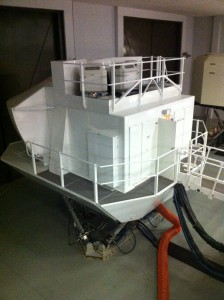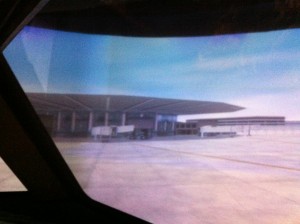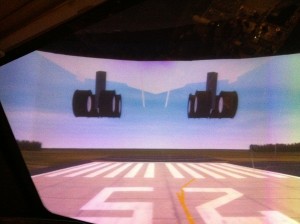Time for a Check-Up
I’m just back from recurrent training — two days of fun and games in the simulator.
I'm just back from recurrent training — two days of fun and games in the simulator. It's kind of like a trip to the dentist: not something you look forward to, but it feels pretty good when it's over. And it's definitely worthwhile.

Each day we showed up at 5 a.m. for the briefing, then went into the "box of pain" at 6:30 for a four-hour session. The first day covers a number of real-life scenarios with some approaches and situations we rarely encounter in day-to-day flying. They don't just throw random emergencies at us; it's all pretty tightly scripted to get the most out of the very expensive time in the simulator. The two pilots alternate between flying duties and non-flying duties. Good crew coordination is a big part of the training.
We flew some approaches we don't often see in the real world, including a localizer only approach (an ILS without a glideslope), an RNAV/RNP approach (a GPS-based approach with several special requirements that the crew must consider), and CAT III and CAT II ILS (very low visibility landings using the plane's auto-land capability).

We had an engine failure on takeoff from Orlando on a hot day with a heavy airplane, which is a worst-case scenario for an engine failure (the four H's that will decrease aircraft performance are High, Hot, Heavy and Humid). We had another engine failure flying out of Costa Rica later in the session. Both of these scenarios ended with single-engine approaches in low visibilty.
We also had two situations testing our use of proper procedures when flying the trans-oceanic track system. One was a divert from our track due to weather avoidance, and the other was an engine failure while over the ocean, requiring us to initiate a diversion.
The last scenario I recall was a pressurization failure while over critically high terrain. This presents some unique problems, because we can't just zoom down like we would if terrain weren't an issue. Again, we have special procedures that we have to execute.

On the second day we do more of the same, plus we have a Line Oriented Evaluation (LOE), which is a complete flight during which some abnormal situation will arise. Because it's done in real time, they always pick a short flight. In our case, New York to Philadelphia.
The LOE incorporates all the things we would do for a normal flight, including pre-flight preparation, reviewing the flight plan, pushing back from the gate, starting engines, etc. This exercise checks the crew's ability to work as a team, using available resources to manage the flight. You never know what kind of problem might crop up.
On this particular LOE we had an engine that began to surge erratically halfway to Philadelphia. We ran all the appropriate checklists and made an uneventful landing with the bad engine back at idle power and using only partial flaps, as dictated by the emergency procedures. There was nothing dramatic, and the instructor had very few items to discuss during the debrief, which is always a sign that things went well.
After the LOE we still had some time available in the sim. I was given an overweight landing in Jacksonville, Florida. The considerations for this landing are to minimize the descent rate (impact) at touchdown and then to spread out the deceleration over the entire length of the runway to try to avoid overheating the brakes. After any overweight landing, a logbook entry is required and a thorough inspection of the airframe must be done before the next flight.

As we rolled out, I looked up to see a 747 on short final coming right at us! I quickly considered my options. Keying the mike and broadcasting on the Tower frequency probably wouldn't have been a bad idea, something like "Aircraft on short final to Runway Seven, go around! There's an aircraft on the runway!" The only other thing we could do would be to get off the runway. As I started to push the throttles forward to make a dash for the taxiway, the instructor piped up and said, "Disregard that plane. I hit a wrong button back here." So we just watched as the 747 passed close overhead. At least if it hit us, the impact would be painless.
Before we left the sim, I asked our instructor to recreate this situation so I could get a picture, but this is the best I could do.
So now, with my "just flossed" feeling, I'm ready to head back to normal, uneventful flying in the real world. Next stop: Madrid.

Each day we showed up at 5 a.m. for the briefing, then went into the "box of pain" at 6:30 for a four-hour session. The first day covers a number of real-life scenarios with some approaches and situations we rarely encounter in day-to-day flying. They don't just throw random emergencies at us; it's all pretty tightly scripted to get the most out of the very expensive time in the simulator. The two pilots alternate between flying duties and non-flying duties. Good crew coordination is a big part of the training.
We flew some approaches we don't often see in the real world, including a localizer only approach (an ILS without a glideslope), an RNAV/RNP approach (a GPS-based approach with several special requirements that the crew must consider), and CAT III and CAT II ILS (very low visibility landings using the plane's auto-land capability).

We had an engine failure on takeoff from Orlando on a hot day with a heavy airplane, which is a worst-case scenario for an engine failure (the four H's that will decrease aircraft performance are High, Hot, Heavy and Humid). We had another engine failure flying out of Costa Rica later in the session. Both of these scenarios ended with single-engine approaches in low visibilty.
We also had two situations testing our use of proper procedures when flying the trans-oceanic track system. One was a divert from our track due to weather avoidance, and the other was an engine failure while over the ocean, requiring us to initiate a diversion.
The last scenario I recall was a pressurization failure while over critically high terrain. This presents some unique problems, because we can't just zoom down like we would if terrain weren't an issue. Again, we have special procedures that we have to execute.

On the second day we do more of the same, plus we have a Line Oriented Evaluation (LOE), which is a complete flight during which some abnormal situation will arise. Because it's done in real time, they always pick a short flight. In our case, New York to Philadelphia.
The LOE incorporates all the things we would do for a normal flight, including pre-flight preparation, reviewing the flight plan, pushing back from the gate, starting engines, etc. This exercise checks the crew's ability to work as a team, using available resources to manage the flight. You never know what kind of problem might crop up.
On this particular LOE we had an engine that began to surge erratically halfway to Philadelphia. We ran all the appropriate checklists and made an uneventful landing with the bad engine back at idle power and using only partial flaps, as dictated by the emergency procedures. There was nothing dramatic, and the instructor had very few items to discuss during the debrief, which is always a sign that things went well.
After the LOE we still had some time available in the sim. I was given an overweight landing in Jacksonville, Florida. The considerations for this landing are to minimize the descent rate (impact) at touchdown and then to spread out the deceleration over the entire length of the runway to try to avoid overheating the brakes. After any overweight landing, a logbook entry is required and a thorough inspection of the airframe must be done before the next flight.

As we rolled out, I looked up to see a 747 on short final coming right at us! I quickly considered my options. Keying the mike and broadcasting on the Tower frequency probably wouldn't have been a bad idea, something like "Aircraft on short final to Runway Seven, go around! There's an aircraft on the runway!" The only other thing we could do would be to get off the runway. As I started to push the throttles forward to make a dash for the taxiway, the instructor piped up and said, "Disregard that plane. I hit a wrong button back here." So we just watched as the 747 passed close overhead. At least if it hit us, the impact would be painless.
Before we left the sim, I asked our instructor to recreate this situation so I could get a picture, but this is the best I could do.
So now, with my "just flossed" feeling, I'm ready to head back to normal, uneventful flying in the real world. Next stop: Madrid.
/https://tf-cmsv2-smithsonianmag-media.s3.amazonaws.com/accounts/headshot/Steve-Satre-headshot.jpg)
/https://tf-cmsv2-smithsonianmag-media.s3.amazonaws.com/accounts/headshot/Steve-Satre-headshot.jpg)